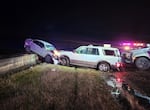While many of the disruptions of the pandemic have eased this year, the surge in traffic fatalities is showing few signs of abating. Policymakers are trying a number of tactics to respond.
The death toll on the roads reached a 20-year high last year across Oregon and Washington. Through November of this year, the number of traffic fatalities is down only slightly in Oregon — off about 6% from last year’s bloody pace. And in Washington, it’s kept on rising and is on track to surpass 700 for the year, said Washington Traffic Safety Commission Director Shelly Baldwin.
“That’ll be the highest numbers that we’ve seen since the ‘90s. It’s a distressing place to find ourselves,” she told members of the state House Transportation Committee during a briefing Thursday.
“Everything has gone up,” Baldwin continued, meaning crashes involving speeding, drugs or alcohol, distraction and unfastened seat belts.

Crash fatalities on the roads surged during the pandemic and have hardly slowed as traffic volumes and congestion returned.
Courtesy of the Oregon State Police
Another aspect Baldwin raised was the slow and halting recovery in traffic enforcement. The number of tickets issued dipped sharply at the beginning of the pandemic when a lot of drivers stayed home and officers minimized face-to-face contacts. Since then, citations have not returned to anything close to the pre-pandemic norm although traffic volumes are more or less back to normal now.
“We know that law enforcement is experiencing hiring/workforce issues and we can see it in the data,” Baldwin said.
Washington State Patrol spokesman Chris Loftis said the agency would like to have around 683 troopers assigned to regular on-the-road patrols statewide. But at last count, it only had 521 available road troopers.
Loftis said the state patrol has been operating with a stubborn 150- to 200-trooper deficit for a few years. Multiple factors have played a part, including the COVID vaccine mandate, retirements, attrition and personnel transfers to higher paying police departments.
“Like other law enforcement agencies in the state and country, we are stretched thin and must develop recruitment, training and retention strategies that can address these widening gaps between need and capacity,” Loftis said via email Monday.
Oregon State Police Cpt. Kyle Kennedy said his agency has budget authorization for 530 road troopers and sergeants, but only 450 of those positions are filled.
To bend the curve on road deaths, legislators in a number of state capitals are showing renewed interest in lowering the drunk driving limit from .08 to .05 blood alcohol concentration. Two Democratic senators from Snohomish County this week pre-filed just such a proposal for consideration by the 2023 Washington Legislature.
“We have seen a dramatic increase in traffic fatalities in our state and around the country and feel some urgency to take action,” state Sen. Marko Liias, chair of the Washington Senate Transportation Committee, said during a late September work session.
In 2019, Oregon and California legislators considered but did not pass bills to lower the legal blood alcohol limit to 0.05. The lead sponsor of the Oregon legislation, Senate President Peter Courtney, did not seek reelection this year, but the proposal could resurface in 2023 with another proponent.
Both the Oregon and Washington traffic safety commissions received extra federal money from pandemic relief packages for crash reduction campaigns. The money was partly earmarked to pay officer overtime to conduct high visibility emphasis patrols for speeding, distraction and impaired driving. Baldwin and her Oregon counterpart said that was a useful strategy, but sometimes hindered by ongoing staff shortages in police forces.
One “startling” component of recent traffic fatality statistics is the big increase in the number of pedestrians and bicyclists killed. The 145 pedestrians killed by vehicles in 2021 statewide in Washington was the highest number on record, Baldwin said, and represented a nearly 32% increase from 2020.
Last year, Portland suffered more pedestrian deaths than at any time in modern history. A report from the Portland Bureau of Transportation documented that about 70% of the victims in 2021 (19 out of 27) were homeless at the time.
A common response to pedestrian deaths that cities are deploying is to lower the speed limit on roads with high crash rates or adding speed bumps and redesigning streets.


